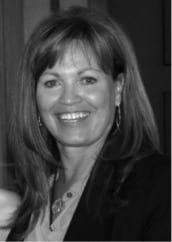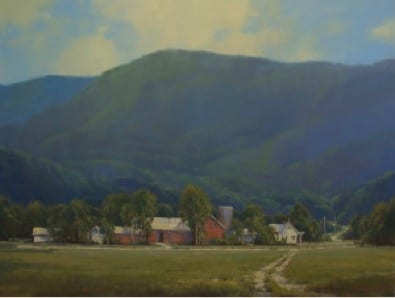In July of 2013, I asked a group of women artists if they noticed any significant differences in the way male and female artists are accepted within the American art scene. Cindy Baron, one of the women asked to comment, senses there is a difference in how the two genders are perceived in the marketplace. Men are considered to be more serious about their work than women.

Commenting on the difference in support received, Baron notes, “Most male artists have a support system behind them. As women, we have a natural tendency to support everyone around us, and most often we are unsupported or not taken seriously.”
Well, there is little doubt that this Rhode Island artist is totally committed to her work. She is one of the few artists accomplished in pastel, watercolor and oil, while being awarded signature membership status in the American Watercolor Society and Oil Painters of America. Quite an achievement for those that might question her seriousness.
It’s my pleasure to bring you this inspiring interview with Cindy Baron.
Why are you an artist?
It is a vocation for me – I could not imagine doing anything else with my life. Art is about creating beauty, and I have been doing that for as long as I can remember.
If you were not an artist, what would you like to be?
I would definitely be a carpenter. I’m sure that sounds funny coming from a woman, but I love construction, building and woodworking. In my early twenties I helped build a house and learned so much – from roofing to masonry. It was a two-story English Tudor with lots of stonework and woodwork. I truly enjoyed the experience and would love to do it again.

What have been the major challenges you’ve had to face in order to establish yourself as a professional artist?
My biggest challenges have been timing…and myself! I am very hard on myself, many artists are. I am always challenging myself to be better, to see the landscape simpler.

Princess Diana famously said, “if you mess up raising your family, then nothing else matters”. I believe that. I would not be where I am today had it not been for my sons. Through patience, I have gained tremendous passion for my art and it has become clear about where I want it to go.
Your paintings are very atmospheric; what are the key points one needs to know when creating a true sense of atmosphere?

What is the major thing you look for when selecting a subject?
I’m attracted to shapes and edges or drama of the scene. A coastal landscape has the wonderful movement and big value changes. Mountains have all the elements of shapes, edges and subtle changes. I love to draw, so I look for certain edges to focus on and how I can enhance the lighting on it.
When designing a painting, do you attempt to simplify and minimize value masses? How do you determine those value masses?
I will be the first one to tell you I can complicate a painting more than anyone else. Simplifying has been continuous development work for me. This is where my sketchbook and field studies are key. To enhance that, most of my paintings start with just a tonal wash of a warm value and then I work on shapes and decide my value ranges. This has been very helpful to me. I also have a friend in a mirror. I have a large one directly behind me when I am at the easel. I am constantly checking my drawing and painting through this process. It won’t lie.
Please share with us your working process.

Do you consider the process of painting more important than the result?
No, the result is the key. It doesn’t matter how you get there, it’s if you achieved what was in your mind and your heart.
How much of your work is intellectual vs. emotional…and how would you define the difference?
This is a hard one to give a percentage to, but when you are so moved to create what you feel, I don’t think anything can stop you. Intellectually you know the structure of a good painting that has come from time spent in the field and studio. Of course you need both, but passion plays a tremendous role for without it you would just be going through the motions. Most of my life has been spent in the sports arena and it takes a lot of passion, dedication and discipline to succeed, not just athleticism. I apply that concept to fine art; academics without heart and soul would reflect in your creativity.
What colors are typically found on your palette?
Ultramarine Blue, Cobalt Blue, Permanent Red, Cadmium Yellow Med and Dark, Alizarin, Yellow Ochre, White, Viridian, Savanna Gray, Unbleached Titanium, Black
What part does photography play in your work?
Photography plays about 50% and mostly just for reference. I use my painting studies and black and white sketches. Photographs are great to recall or study a shape, but they are not good for values and depth of a scene. That has to come from you and your recall. The last 20% of my painting is done without any reference and I go mainly on my memory of the scene and what moved me to want to paint it.
What part does plein air painting play in your work?
A huge amount, you have to paint in the field just to gain the knowledge of values and color. I love being outside and my trips I plan every year are more like boot camp. This is where the good, the bad and the ugly happen, but so invaluable to a successful studio painting. That hour or two you spend on a painting, you learn what shapes are good, how to hold your masses and color temperature. The knowledge of this can only be achieved through painting on site.
What qualifies as a plein air painting?
I like using the term “field studies” instead of plein air as most of my work is for capturing knowledge. I almost always paint a little on them in the studio without references and go by the memory of that day. Plein-air I would apply to timed painting events that cannot be painted on later and entered into shows. I love to revisit my field studies and paint on them, great knowledge is gained.

How would you define “success” as an artist?
Peer recognition and wealth would be the go-to answer, but it’s not. Yes I am an artist and I believe that is a gift, but most importantly I am a mom, an entrepreneur, a good friend and most of all, ever evolving. Yes there is success, but it came with discipline, hard work, teaching and a feeling of pride that I am allowed to be an artist.
What’s the most difficult part of painting for you?
Probably calling a painting “finished.” I like to look at my paintings with fresh eyes. When you revisit a painting after not looking at it for a couple of days it is so helpful in problem solving.
How many hours per day do you typically paint?
A typical day starts with coffee, emails than exercise. I am usually at the easel by 11 and will paint till about 5. I break for a couple of hours, but I am a fan of late night painting. I paint every day, it is seldom that a day goes by and I haven’t touched a brush, even if it’s just to lay a couple of strokes on a painting that I see has an issue.
What advice do you have for someone desiring to be an artist/painter?
Be passionate, disciplined, determined. Leave the ego behind and always challenge yourself. You will have good times and hard times and even question your artistic abilities more then you will want to admit. Study from artists you admire – living or deceased – and be open to several mediums to find your expression. Being an entrepreneur has many challenges but know that you were given a gift and it would be a sin to not use it.
If you could spend the day with any three artists past or present, whom would they be?
Tucker Smith, so talented, I love the stories he paints. Edgar Payne, for introducing me to the mountains. And William Trost Richards, I cry when I see his paintings.
What has been your most effective marketing tool?
Several things; one being, my two feet. I have had the privilege of living and traveling around the country and would do my research on galleries, museums and artist that were in the area. Making a personal connection has always been a good avenue. Other tools have been Plein Air events, gallery representation, collector lists, advertisements and the Internet.
For more of Cindy’s work: cindybaron.com
For more about the interviewer, John Pototschnik, visit www.pototschnik.com
Leave a Reply